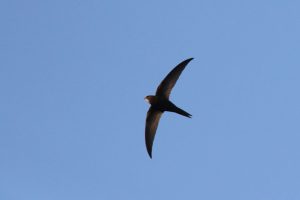Biodiversity enhancement in new housing developments
With the current pressures for building new houses, it becomes more essential than ever that we do so in a way that does not damage, and indeed enhances, the natural environment on which we all depend for our quality of life.
It would be easy to just assume that new houses, even when built in appropriate locations, will destroy or damage the local wildlife environment. However, when built in the right way and incorporating simple and cost effective features, new housing can significantly contribute to enhancing wildlife habitat. This should now be the aim of all those involved in such developments, including the developers, the builders, the local planning authority, future residents and the local community.

This documents sets out ways in which such enhancements can be incorporated into all new developments, based on building in wildlife friendly features at the construction stage and ensuring appropriate planting of native and wildlife friendly trees, shrubs and plants.
As well as improving the immediate environment of the development site, these measures can also contribute substantially to establishing and maintaining wildlife corridors that support the wider landscape.
These approaches have been put together jointly by Campaign to Protect Rural England (CPRE) Sussex and Royal Society for the Protection of Birds (South East). It is our hope that planning authorities will adopt these principles formally as part of their planning policies and guidance so that such provisions become the normal expectation for all those involved in new developments.
Broad principles
- New developments should be designed to integrate space for both wildlife and people, as well as to reduce carbon emissions and minimise water usage.
- They should be designed to retain and fit in with existing wildlife friendly features, such as meadows, wetlands, hedges, trees and woodland. They should enhance this network and establish green corridors that contribute to the wider ecological networks.
- They should incorporate wildlife-rich gardens and other green spaces.
- They should include structural features that enable birds, bats and other creatures to live in harmony with people (see below).
Building for wildlife
In addition to larger scale wildlife-friendly features, such developments should include environmentally sustainable features such as:
- Trees, hedgerows, water and other habitats
- Wildflower verges along roads
- Lighting designed to reduce light pollution and avoid disturbing wildlife
- Integrated bird and bat boxes/bricks built into new houses
- Wildlife –friendly green walls and roofs, which do not need to be the preserve of the houses but could also extend to communal bin areas, bus shelters and bike stores.
- Native wildlife-friendly plants, trees and shrubs
- Street trees
- Interpretation panels to explain the role of these features.
- Hedgehog highways maintaining connectivity through gardens
- Wildlife-friendly sustainable drainage (SuDS)
The benefits for people
- Daily enjoyment of nature
- Improved health
- Sense of community
- More attractive places to live
The benefits for developers
- A more attractive product
- Satisfied customers
- Higher market values
- Enhanced reputation – community responsible developers
- Happier communities.
- Can reduce costs by working with nature rather than against it, e.g. less management required on wildflower grass vs” traditional” amenity grass.
The benefits for local planning authorities
- Sets a standard for the authorities on biodiversity
- Clarifies the position for all applicants on planning expectations
- Show the authority as an upholder of high biodiversity standards
- Helps to meet national requirements for enhanced biodiversity in new developments.
PDF 680.61 Kb


